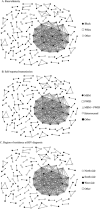HIV-1 Infection and Transmission Networks of Younger People in Chicago, Illinois, 2005-2011
- PMID: 28005480
- PMCID: PMC5298503
- DOI: 10.1177/0033354916679988
HIV-1 Infection and Transmission Networks of Younger People in Chicago, Illinois, 2005-2011
Abstract
Objective: Analysis of HIV nucleotide sequences can be used to identify people with highly similar HIV strains and understand transmission patterns. The objective of this study was to identify groups of people highly connected by HIV transmission and the extent to which transmission occurred within and between geographic areas in Chicago, Illinois.
Methods: We analyzed genetic sequences in the HIV-1 pol region in samples collected from people participating in the VARHS program in Chicago during 2005-2011. We determined pairwise genetic distance, inferred potential transmission events between HIV-infected people whose sequences were ≤1.5% genetically distant, and identified clusters of connected people. We used multivariable analysis to determine demographic characteristics and risk attributes associated with degree of connectivity.
Results: Of 1154 sequences, 177 (15.3%) were tied to at least 1 other sequence. We determined that younger people, men, non-Hispanic black people, and men who have sex with men were more highly connected than other HIV-infected people. We also identified a high degree of geographic heterogeneity-48 of 67 clusters (71.6%) contained people from >1 Chicago region (north, south, or west sides).
Conclusion: Our results indicate a need to address HIV transmission through the networks of younger non-Hispanic black men who have sex with men. The high level of geographic heterogeneity observed suggests that HIV prevention programs should be targeted toward networks of younger people rather than geographic areas of high incidence. This study could also guide prevention efforts in other diverse metropolitan regions with characteristics similar to those of Chicago.
Keywords: HIV; MSM; networks.
Conflict of interest statement
The author(s) declared no potential conflicts of interest with respect to the research, authorship, and/or publication of this article.
Figures


References
-
- Yerly S, Junier T, Gayet-Ageron A, et al. The impact of transmission clusters on primary drug resistance in newly diagnosed HIV-1 infection. AIDS. 2009;23(11):1415–1423. - PubMed
-
- Louwagie J, McCutchan FE, Peeters M, et al. Phylogenetic analysis of gag genes from 70 international HIV-1 isolates provides evidence for multiple genotypes. AIDS. 1993;7(6):769–780. - PubMed
Publication types
MeSH terms
Grants and funding
LinkOut - more resources
Full Text Sources
Other Literature Sources
Medical

